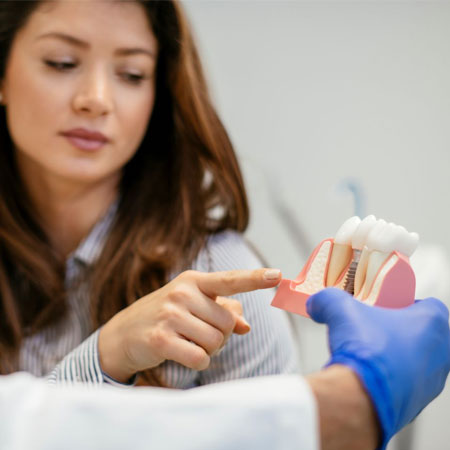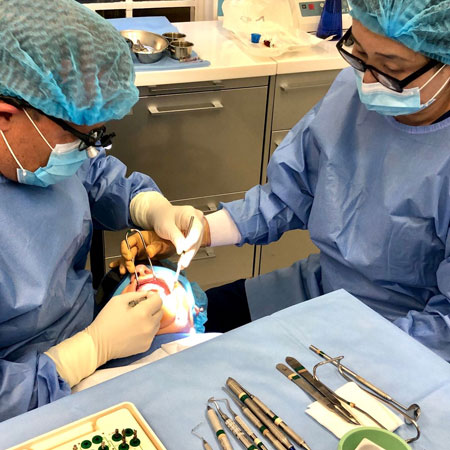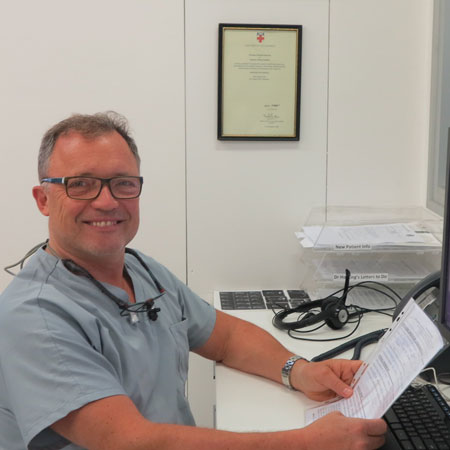Implant Placement
The stages involved...
When carrying out an implant placement, Dr Hocking and his team have a treatment process they follow which is detailed below.
If you have any questions about this process, please contact us.
-

1. Consultation
At the initial consultation, Dr Hocking carries out an information gathering session. We need to know about who you are, not just your dental situation.
-

2. Implant Placement
The patient is sedated and the implant/s placed with multiple intra-operative radiographs confirming ideal implant position.
-

3. Review
Patients are reviewed 3 to 4 months following implant placement - this includes clinical tests, soft tissue assessment, radiographs and ISQ reading.
Consultation
At the initial consultation, Dr Hocking carries out an information gathering session. We need to know about who you are, not just your dental situation. Medical history and current stress levels are very important in determining the best and most appropriate treatment for the patient at this particular time in their life.
Once we have determined that implant supported therapy is the most suitable treatment option, we gather clinical records such as x-rays, photos, examination and charting of the mouth and dentition. We may take impressions so that we can construct things such as provisional partial plates, diagnostic stents, or surgical stents. (These are plastic guides which help Dr Hocking place the implant in exactly the right position to support the future restoration all crown).
We often require a three-dimensional or cone beam radiograph to ascertain how much bone volume is available to support implant placement. In the upper jaw we’re particularly interested in the concavity at the front of the jaw, and the size of the maxillary sinus above the back teeth. In the lower jaw, we are interested in the position of the very important mandibular nerve, which supplies sensation to the lower lip and surrounding skin. This x-ray has been a major breakthrough in making implant placement safer and more predictable.
Once the consultation is complete, patients are always given all treatment options, and then detailed written estimates of the eventual treatment plan. Item numbers are also provided to help patients determine the level of rebate from their private insurer.
Implant Placement
In a typical scenario, patients will then return another day for the surgical placement of the implant. Often they are given either minor oral sedation (Midazolam), or offered the option of IV sedation for more complex or longer cases. IV sedation is carried out by our anaesthetist, Dr Peter Andrews. He has had over 30 years experience providing hospital sedation in various departments including gastroenterology and A&E.
The implant is then placed, with multiple intraoperative radiographs confirming ideal position along the way.
We always request that patients are collected by a responsible carer so they get home safely. Of course any form of sedation means there can be no driving or operating equipment for the rest of the day, it’s best to go straight home and relax in front of the TV.
All patients are contacted the next day to make sure they got home safely and they are taking the medication provided. We don’t hand out scripts hoping patients will stumble into a chemist for the appropriate antibiotics. We provide a goodie bag with all medication required to ensure a comfortable safe and successful healing period.
Patients are then reviewed and sutures removed 10 days later.
Review
We review patients 3 to 4 months following implant placement. We confirm implant integration has been successful with clinical tests such as assessment of the soft tissue, radiographs, and the use of the Osstell device to give us an ISQ reading (implant stability quotient). In the vast majority of cases, the ISQ is above 64 at the review appointment, and therefore the implant is safe to restore. In the rare cases it is below that number we sometimes wait for 3 more months to allow for further healing.
Once integration is confirmed, we then return the patient to the care of the referring restorative dentist. He can then provide the definitive restoration for the implant. Dr Hocking will always write to the referring dentist at this stage, providing them with any information required, along with any guidance that might be helpful to achieve the ideal outcome for the patient.